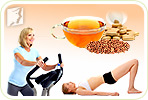While many menopause symptoms are physically unpleasant, loss of libido is one of the most difficult ones to also deal with emotionally. Fortunately, middle-aged women can put efforts in to address the hormonal imbalance at fault and fully restore their sex drive through a variety of approaches.
Read on to discover the best treatments for low libido in females going through menopause, and rekindle the passion far into your twilight years!
Three Approaches to Treating Loss of Libido
There are three approaches to treating loss of libido: (1) Lifestyle changes, (2) Alternative medicine, and (3) Medications, which range from low-risk options to more invasive treatments.
Lifestyle Changes for Low Libido Treatment

The first level of treatment for decreased libido in females involves the least amount of risk, though it does require the highest amount of self-discipline.
Nutritious Diet
A well-balanced diet can be a tremendous treatment for low libido in females and a great way to achieve a higher level of health. Menopausal meals should be composed of wholesome sources of lean protein, complex carbs, and healthy fats that are rich in the following nutrients:
- Phytoestrogens, or plant estrogens, work to relieve symptoms of low libido by promoting hormonal balance.
Soy, tofu, tempeh, flax
- Zinc is needed for hormone synthesis, both thyroid and reproductive, which directly influences women's libido.
Oysters, pumpkin seeds, kidney beans, and red meat (in moderation)
- Vitamin D deficiency has been found in women with sexual dysfunction, including low sex drive and lubrication.1
Eggs, salmon, mushroom, oranges, apricots
- Quercetin is a flavonoid whose vasodilatory properties may contribute to improving sexual desire and function.2
Apples, cherries, dark berries, capers, cocoa
- L-arginine is an acid that is converted to nitric oxide in the body and boosts blood flow to the genitalia.3
Walnuts, pumpkin or sunflower seeds, spirulina, shrimp
Additionally, research has shown that regular, moderate consumption of red wine can also help in low libido treatment as it can improve women's sexual satisfaction, including arousal, vaginal lubrication, and function.4
Regular Exercise
Regular physical activity not only contributes to stress reduction, but can also tone the body, prevent weight gain, increase blood flow to the genital area, and improve self-image, all of which act as an effective low libido treatment.
Amount: An ideal exercise routine consists of at least 150 minutes of low- to moderate-level physical activity per week, evenly broken up into shorter, 30-minute trainings.
Type: Combining yoga for increased flexibility, Kegel exercises for vaginal muscle strengthening, and aerobics for better blood flow to the pelvic area can bring desired results of improved sexual desire as well as function.5,6
Useful tips: Weather permitting, a woman is advised to opt for exercising outdoors to benefit from the effects of vitamin D on mood, hormone balance, and sexual desire.
Precautions: To prevent fractures, it is best for middle-aged women to stay away from strenuous forms of exercise, like heavy weight lifting.
Wholesome Habits
Women can complement their diets and exercise regimens with various wholesome habits, which - when practiced consistently - can help restore their libido and help them get through this life stage more empowered.
Relieving stress with yoga, meditation, or deep breathing exercises is one of the best ways to prevent the negative effects of elevated cortisol and adrenaline on hormones and sexual desire.
Communicating openly with one's partner about fears and difficulties to prevent misunderstandings and alienation can strengthen the relationship as both partners work together to fulfill each other's sexual needs.
Being playful in the bedroom - which might consist of spending more time on foreplay, trying different positions, or using sex toys - can take off the pressure of having sex, make it more fun, and reignite the passion.
Considering vaginal lubricants or moisturizers can address the dryness behind low of libido in women. Because oil-based choices can deteriorate latex condoms, it is best to select water-based options.
- Quitting addictions to smoking can help treat low libido as it has been found to decrease vaginal lubrication and orgasm frequency.7
Alternative Medicine for Low Libido Treatment

Considered affordable and low-risk, alternative medicine can be highly effective in treating loss of libido, especially alongside lifestyle changes.
There are two kinds of supplementary herbs that may be used in the treatment for low libido in females: phytoestrogenic and hormone-regulating herbal supplements.
Phytoestrogenic Supplements
Phytoestrogenic herbs, such as ginseng and chasteberry, contain plant-based compounds that resemble estrogen. By introducing these estrogenic compounds into the body, phytoestrogenic herbal supplements help to correct an estrogen deficiency and mitigate hormonal fluctuations. However, adding outside hormones to the body can directly reduce its capability to produce its own hormones. In the long term, this may cause an even greater drop in hormone levels.
Hormone-Regulating Herbal Supplements
In contrast, these supplements do not contain plant estrogens or any external hormones. Rather, they promote natural hormone production by nourishing the endocrine glands. This results in a balance of not only estrogen, but progesterone and testosterone levels as well, thus improving libido. These supplements are considered the safest and most effective low libido treatment options since they lack side effects and stimulate hormone production from within.
From Nature and Health Magazine, Dr. Chacon says:
"Macafem's nutrients help restore natural hormones in women. Unlike hormone drugs, which are basically resumed in taking synthetic hormones, Macafem acts totally different in your body. It nourishes and stimulates your own natural hormone production by inducing the optimal functioning of the pituitary and endocrine glands." Click on the following link if you want to learn more about Macafem.
A combination of lifestyle changes and herbal supplements is usually the most effective treatment for women's low libido. However, some women struggle with severe symptoms that might require a more advanced and risky treatment method, namely medications.
Medications for Low Libido Treatment

This approach carries the highest risk and is often the costliest as well.
Hormone Replacement Therapy (HRT)
Once a very popular treatment method for menopausal ailments, HRT - containing estrogen, progesterone, testosterone, or their combination - is not prescribed as widely as before. While it can still be a quick and powerful low libido treatment, it also involves serious side effects and increases the risk of blood clots, cancers, and heart disease, as seen in the following studies.
The 2002 reports from the Women's Health Initiative, published in JAMA, revealed that women taking HRT are more prone to serious health risks, including breast cancer, heart disease, and strokes.8 A more recent (2019) Oxford University study on HRT's effects not only confirmed the WHI's findings, but also discovered that the risks of hormonal therapy may persist for over a decade.9
Other Low Libido Treatments
Besides HRT, there are other forms of treatment for low libido in females that might be considered, such as the following:
Pelvic floor physical therapy can loosen tight muscles in the pelvis and groin, improve blood flow, and help improve sexual desire.
Prescription vaginal lubricants or moisturizers can keep vaginal tissue healthy and moist, thus helping women enjoy sex and prevent irritation.
Libido enhancers, like flibanserin or bremelanotide, can be prescribed to premenopausal women with low libido.
Antidepressants may boost sex drive in women suffering from depression, especially alongside psychotherapy; however, some antidepressants may decrease libido even further.
Psychotherapy may benefit women whose low libido is related to depression or other mental health conditions.
The three aforementioned approaches to low libido treatment - lifestyle changes, alternative medicine, and medications - can be applied in any combination, depending on symptom severity and a woman's health status. Yet, a growing number of women manage to reignite their sexual drive through a blend of healthy lifestyle changes and hormone-regulating herbal supplements without ever relying on risky treatments.
A Safe Treatment for Loss of Libido
Implementing Lifestyle Changes:
- Loading up on foods rich in phytoestrogens, zinc, L-arginine, and vitamin D
- Doing yoga, Kegel exercise, and aerobics 5 times a week, 30 min a day
- Relieving stress through yoga, meditation, and deep breathing exercises
- Practicing openness with one's partner and new forms of sexual stimulation
And Taking Herbal Supplements:
- Phytoestrogenic herbal supplements, like chasteberry or ginseng
- Or natural hormone-regulating supplements, like Macafem
Sources
- Better Health Channel. (2018). Libido. Retrieved February 3, 2020 from https://www.betterhealth.vic.gov.au/health/healthyliving/libido
- BioMed Research International. (2014). A Review on Plants Used for Improvement of Sexual Performance and Virility. Retrieved February 3, 2020 from https://www.ncbi.nlm.nih.gov/pmc/articles/PMC4151601/
- Harvard Health Publishing. (n.d.). 11 Ways to Help Yourself to a Better Sex Life. Retrieved February 3, 2020 from https://www.health.harvard.edu/healthbeat/11-ways-to-help-yourself-to-a-better-sex-life
- Hormones and behavior. (2016). Increasing women's sexual desire: The comparative effectiveness of estrogens and androgens. Retrieved February 3, 2020 from https://www.ncbi.nlm.nih.gov/pmc/articles/PMC4720522/
- International Society for Sexual Medicine. (2015). Natural Aphrodisiacs—A Review of Selected Sexual Enhancers. Retrieved February 3, 2020 from https://onlinelibrary.wiley.com/doi/epdf/10.1002/smrj.62?referrer_access_token=d9oiuG2OdM2VMh2pHbw5mE4keas67K9QMdWULTWMo8PSGvkI-YNI4AXKUMozbSRH3AR-VjMybyxbEd9oVa4jUUeglmag5_94782mzfpIlelN4Nbivg5tTRkSk0ILpbfaLz1UvepDLw6PtESDOesaAg%3D%3D
- International Society for Sexual Medicine. (n.d.). What is pelvic floor physical therapy? Retrieved February 3, 2020 from https://www.issm.info/sexual-health-qa/what-is-pelvic-floor-physical-therapy/
- Journal of the Turkish-German Gynecological Association. (2017). Retrieved February 3, 2020 from https://www.ncbi.nlm.nih.gov/pmc/articles/PMC5776161/
- Mayo Clinic. (2018). Low sex drive in women. Retrieved February 3, 2020 from https://www.mayoclinic.org/diseases-conditions/low-sex-drive-in-women/diagnosis-treatment/drc-20374561
- NHS. (2020). Loss of libido (reduced sex drive). Retrieved February 3, 2020 from https://www.nhs.uk/conditions/loss-of-libido/
- Office on Women's Health. (2018). Menopause and sexuality. Retrieved February 3, 2020 from http://womenshealth.gov/menopause/menopause-sexuality/
- The Journal of Sexual Medicine. (2010). Women's Sexual Health: Adherence to Mediterranean Diet and Sexual Function in Women with Type 2 Diabetes. Retrieved February 3, 2020 from https://www.sciencedirect.com/science/article/pii/S1743609515330307
- University of California, San Francisco. (n.d.). Decreased libido. Retrieved February 3, 2020 from https://urology.ucsf.edu/patient-care/adult-non-cancer/male-sexual-and-reproductive-health/decreased-libido
- University of Chicago Medicine. (2019). Vyleesi? Addyi? How women can get help for low sexual desire. Retrieved February 3, 2020 from https://www.uchicagomedicine.org/forefront/womens-health-articles/vyleesi-addyi-how-women-can-get-help-for-low-sexual-desire
Footnotes:
- International Urology and Nephrology. (2016). Vitamin D3 deficiency is associated with female sexual dysfunction in premenopausal women. Retrieved February 3, 2020 from https://www.ncbi.nlm.nih.gov/pubmed/27522658
- Nutrients. (2016). Quercetin, Inflammation and Immunity. Retrieved February 3, 2020 from https://www.ncbi.nlm.nih.gov/pmc/articles/PMC4808895/
- Pharmacognosy Review. (2016). Overviews of Biological Importance of Quercetin: A Bioactive Flavonoid. Retrieved February 3, 2020 from https://www.ncbi.nlm.nih.gov/pmc/articles/PMC5214562/
- The Journal of Sexual Medicine. (2010). Regular moderate intake of red wine is linked to a better women's sexual health. Retrieved February 3, 2020 from https://www.ncbi.nlm.nih.gov/pubmed/19627470
- The Journal of Sexual Medicine. (2010). Yoga in Female Sexual Functions. Retrieved February 3, 2020 from https://www.sciencedirect.com/science/article/pii/S1743609515329143/
- Electronic Journal of Human Sexuality. (2004). Sexual Desirability and Sexual Performance: Does Exercise and Fitness Really Matter? Retrieved February 3, 2020 from http://www.ejhs.org/volume7/fitness.html
- Andrology. (2015). Relationship between Smoking and Female Sexual Dysfunction. Retrieved February 3, 2020 from https://www.longdom.org/open-access/relationship-between-smoking-and-female-sexual-dysfunction-2167-0250-1000144.pdf
- JAMA. (2002). Risks and benefits of estrogen plus progestin in healthy postmenopausal women: principal results from the Women's Health Initiative randomized controlled trial. Retrieved February 3, 2020 from https://www.ncbi.nlm.nih.gov/pubmed/12117397
- The Lancet. (2019). Type and timing of menopausal hormone therapy and breast cancer risk: individual participant meta-analysis of the worldwide epidemiological evidence. Retrieved February 3, 2020 from https://www.thelancet.com/journals/lancet/article/PIIS0140-6736(19)31709-X/fulltext



